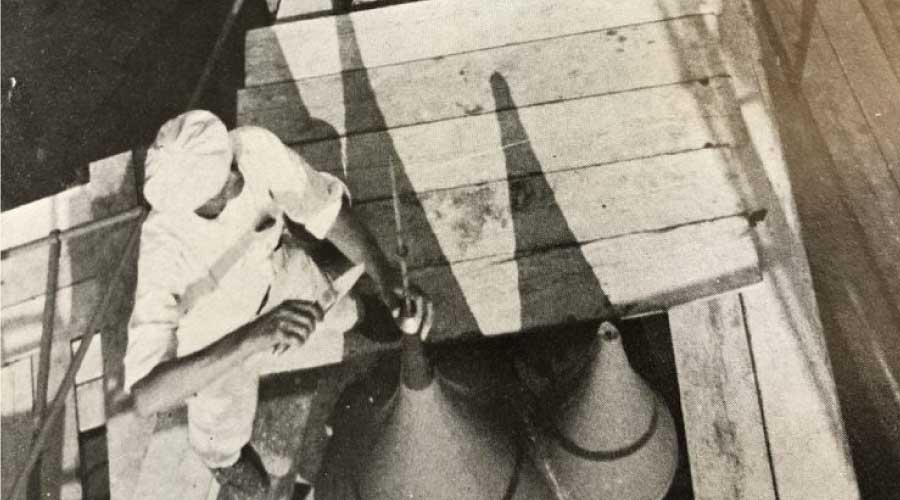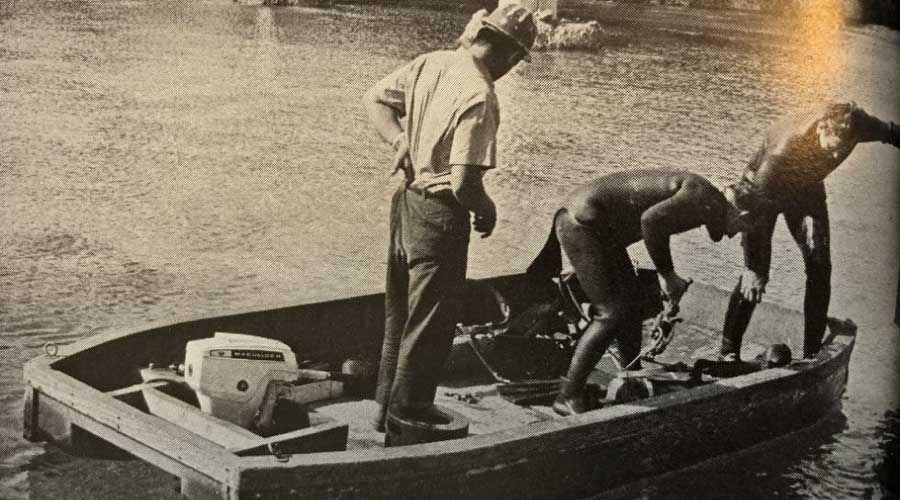 High above Fantasyland, a maintenance crewman repaints one of the spires of Sleeping Beauty Castle.
High above Fantasyland, a maintenance crewman repaints one of the spires of Sleeping Beauty Castle.From the Archives: Maintaining Disneyland in the 1960s
In honor of Disney’s 100th anniversary, we’ve unarchived this Building Operating Management article from 1969 about maintaining the theme park
By By Morris D. Wertenberger, Jr., former technical editor for Building Modernization and Maintenance
In 2024, Building Operating Management is celebrating its 70th anniversary. Editor-in-Chief Dan Weltin has been looking through the archives for our upcoming anniversary coverage that will be made available next year. In honor of Disney’s 100th anniversary, we’ve unarchived the following article, “Backstage at Disneyland” which originally appeared in the October 1969 issue of Building Modernization and Maintenance, the former name of Building Operating Management.
“Trying to keep the park clean is a tremendous expense. And those sharp pencil guys tell you, ‘Walt, if we cut down on maintenance, we’d save a lot of money.’ But I don’t believe that — it’s like any other show on the road; it must be kept clean and fresh.”
Walt Disney said that in 1965.
But keeping Disneyland “clean and fresh” requires uncommon skills varying from the A of Ager and Grainer, making new wood look old, to the Z of Zebra Taxidermist.
And it is expensive too. Today’s annual maintenance budget equals almost half the original cost of the park in 1955. Current capital investment tops $100 million.
On a good summer day 60,000 people will tromp through the park leaving 6 tons of trash in their wake. In spite of this onslaught, Disneyland keeps its fresh and happy complexion. Part of the secret is 120 men, mostly local college students, who constantly police public areas. Rumor has it no discarded cigarette butt ever gets cool before a white-clad worker expertly flicks it into a lobby pan.
 Mr. Sea Bass gets a touch-up in the paint shop. Underwater figures are repainted every three months to 1 and a half years.
Mr. Sea Bass gets a touch-up in the paint shop. Underwater figures are repainted every three months to 1 and a half years.
During the summer the park is open 16 hours a day, seven days a week. In order to keep it early morning fresh at closing time much of the cleaning must be done in full view of the guests. But Disneyland is a theme park. Millions have been spent to create total environment. Not in keeping with the Magic Kingdom image would be tattered cleaning workers pushing decrepit cleaning carts down Main Street.
Disney “Imagineers” (the design people) blanch at the very idea. Instead, cleaning is either made part of the show or is so inconspicuous no one notices. The Disneyland Sanitation Department is a good example of sleight-of-hand housekeeping. The first charm to greet guests is a two-block long typical turn of the century Main Street. Ornate gingerbread decorates the buildings. There is the general store. Here an old-fashioned soda fountain. Horse-drawn cars clatter down the street — followed closely by a man with a large push broom, a shovel and a barrel mounted on wheels. He is a member of the Disneyland Sanitation Department. Dressed in typical togs of the 1900’s he becomes part of the show — rather than an intrusion.

Maintenance crew are often made part of the show. On turn-of-the-century Main Street, for example, this worker dressed in period appropriate attire is part of the act.
Where cleaning simply cannot be made part of the show then it is made inconspicuous. Each pair of restrooms share a fully equipped service closet so cleaning and policing can take place with dragging tools through the park. Each closet, built so that it opens directly into both the men’s and women’s room has a red light over each door. When either door is open the light on the other door is lit, warning the other attendant.
Disneyland has even made trash containers part of the show. They are works of art — literally. Many are hand painted to match the mood and theme of the area. In Tomorrowland the containers are painted stark, modish silver. In Jungleland they resemble bamboo while the ones in New Orleans Square feature a French Provincial paint job. Disneyland is a sum total of elegantly executed details.
Keeping the trash cans painted is just one of the Maintenance Department’s many jobs. It is probably the only landlocked maintenance department in the country with frogmen on the payroll. The divers keep busy servicing everything from the mermaids in the Submarine Voyage lagoon to alligators in the Jungle Cruise.
 In the submarine lagoon, frogmen prepare to drop into the deep to check on several three-dimensional animated sea creatures.
In the submarine lagoon, frogmen prepare to drop into the deep to check on several three-dimensional animated sea creatures.
The water is Disneyland presents an interesting maintenance problem. WED Enterprises, Inc., the Disney planning and design firm, creates all of the attractions. One of their design tools is water turbidity. In the Jungleland cruise, where there is much mechanical animation just below the surface, the water is kept very murky — though clean — through dyes. But in the Submarine Voyage the water is much clearer. Not too clear, though. Visibility drops off at about 40 feet which is roughly the edge of the man-made lake. A careful balance of filtering and chlorine counts keeps the water visibility just right.
The importance of the maintenance function can be judged by the size of its area. The park, “on stage” as Disney people call it, occupies 70 acres. “Back stage,” home of Maintenance and a few other functions occupies 30 acres.
It takes some 251 skills to keep Disneyland running. There are men who can fix monorail trains and others who can repair the pneumatic cylinder used to wiggle a mechanical pig’s tail.
 A crew of 12 services the world’s first daily operating monorail system.But not all Disneyland is mechanical. Landscaping plays an important role in the Disneyland panorama.
A crew of 12 services the world’s first daily operating monorail system.But not all Disneyland is mechanical. Landscaping plays an important role in the Disneyland panorama.
From the main entrance portrait of Mickey Mouse painted in blossoms and leaves to the exotic tropical foliage of Adventureland the continuous interplay between foliage and the theme lands is the real secret of the Magic Kingdom atmosphere.
Thirty eight gardeners tend the $3 million plant collection. Southern California does not have obvious changes of seasons but Disneyland does. Each year 800,000 bedding plants help bring about the change in seasons. At Christmas poinsettias flood the park with brilliant reds. Easter is greeted with gay spring flowers followed shortly by the vibrant colors of summer. During the autumn the fall hues prevail.
To insure the flowers will be ready on schedule heavy use is made of growth retardants. Disney landscape experts have found it easier to retard a bloom due two weeks after you want it than speed up a bloom due two weeks before you need it.
Although Disneyland is virtually a botanical garden in its own right some of the most unusual plants in the Magic Kingdom are the 22 delicate topiary shrubs which garnish the forecourt of “It’s a Small World.” Constantly trained in the shape of fanciful animal figures these living sculptures must be given frequent and precise pampering. Too much, or too little, water, fertilizer or insecticide can reduce three to five years of work to kindling wood almost overnight.
 Trimming the topiary plants requires the skill of a sculptor and the knowledge of a gardener.
Trimming the topiary plants requires the skill of a sculptor and the knowledge of a gardener.
A popular game played by Disneyland guests is, “is it real?” All of the landscaping is living — except a few of the permanent orchids in Jungle Cruise and the world’s only specimen of Disney Odendrum Giangantis. This 70 foot tree contains the Swiss Family Tree House. But electricity, not sap, flows through the trunk.
Like everything in the Magic Kingdom even 300,000 plastic leaves and 50,000 man-made blossoms 70 feet above ground must be kept “clean and fresh.”
Related Topics:









 Mr. Sea Bass gets a touch-up in the paint shop. Underwater figures are repainted every three months to 1 and a half years.
Mr. Sea Bass gets a touch-up in the paint shop. Underwater figures are repainted every three months to 1 and a half years.
 In the submarine lagoon, frogmen prepare to drop into the deep to check on several three-dimensional animated sea creatures.
In the submarine lagoon, frogmen prepare to drop into the deep to check on several three-dimensional animated sea creatures.  A crew of 12 services the world’s first daily operating monorail system.But not all Disneyland is mechanical. Landscaping plays an important role in the Disneyland panorama.
A crew of 12 services the world’s first daily operating monorail system.But not all Disneyland is mechanical. Landscaping plays an important role in the Disneyland panorama.  Trimming the topiary plants requires the skill of a sculptor and the knowledge of a gardener.
Trimming the topiary plants requires the skill of a sculptor and the knowledge of a gardener. 


